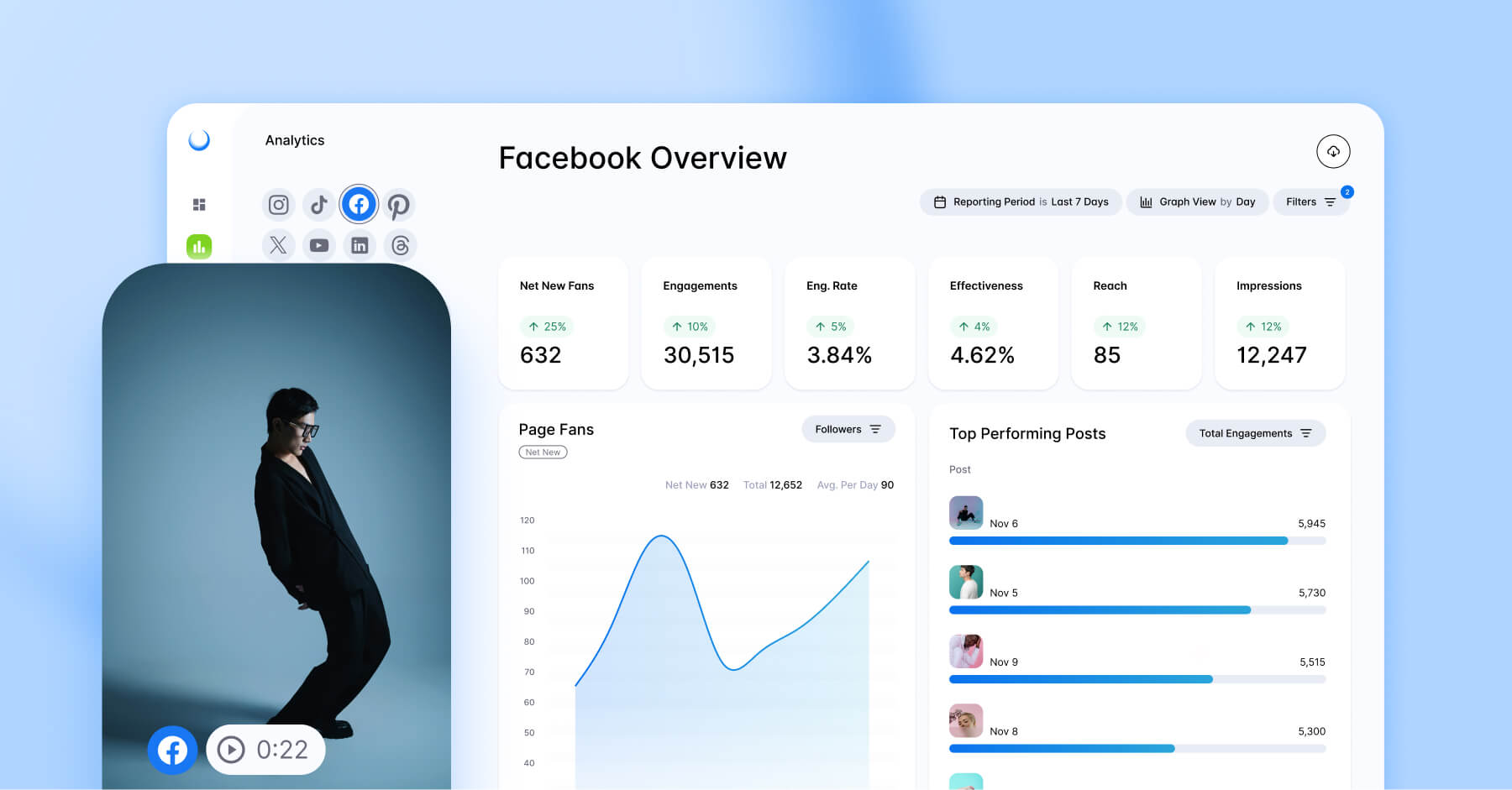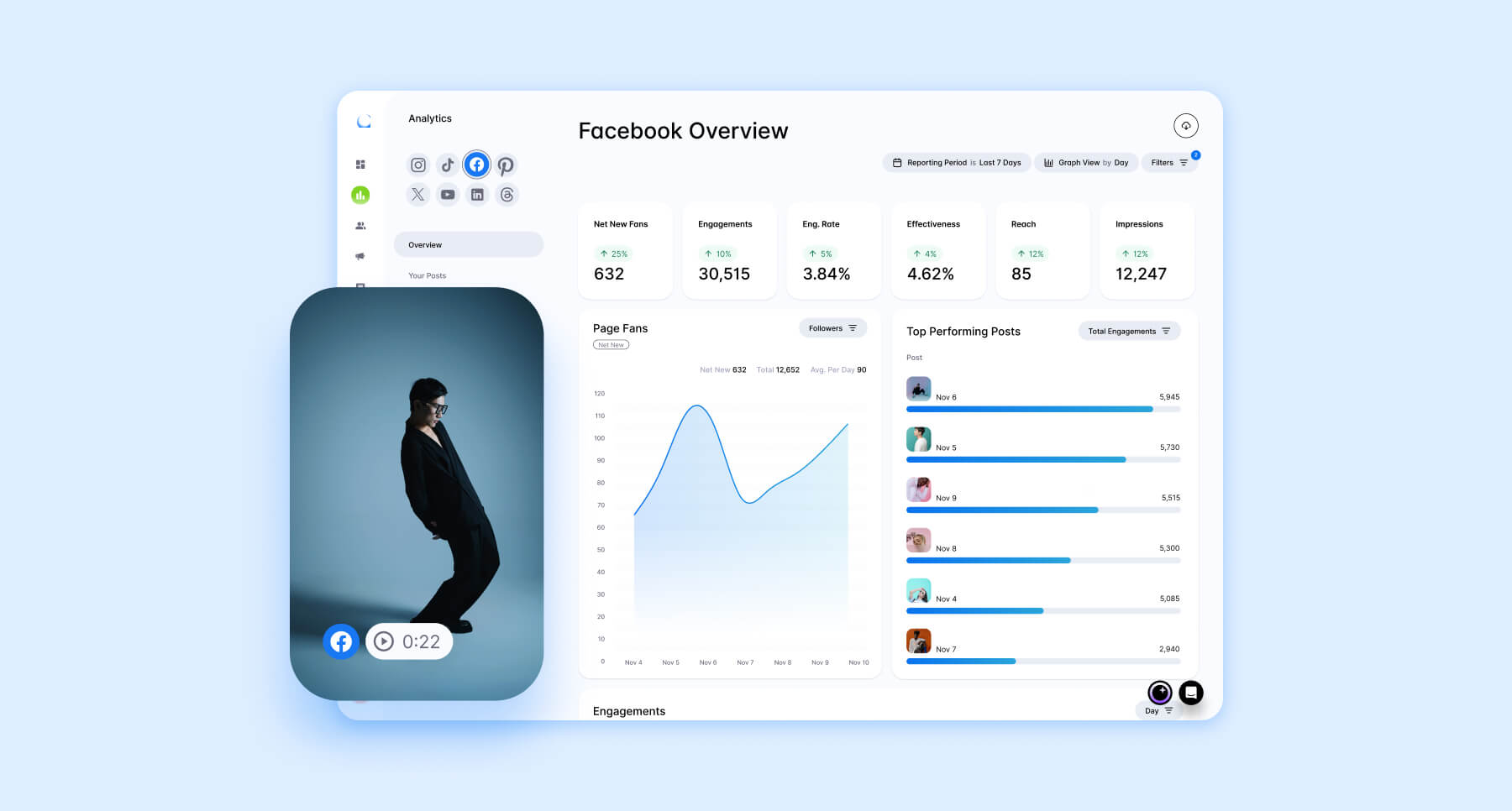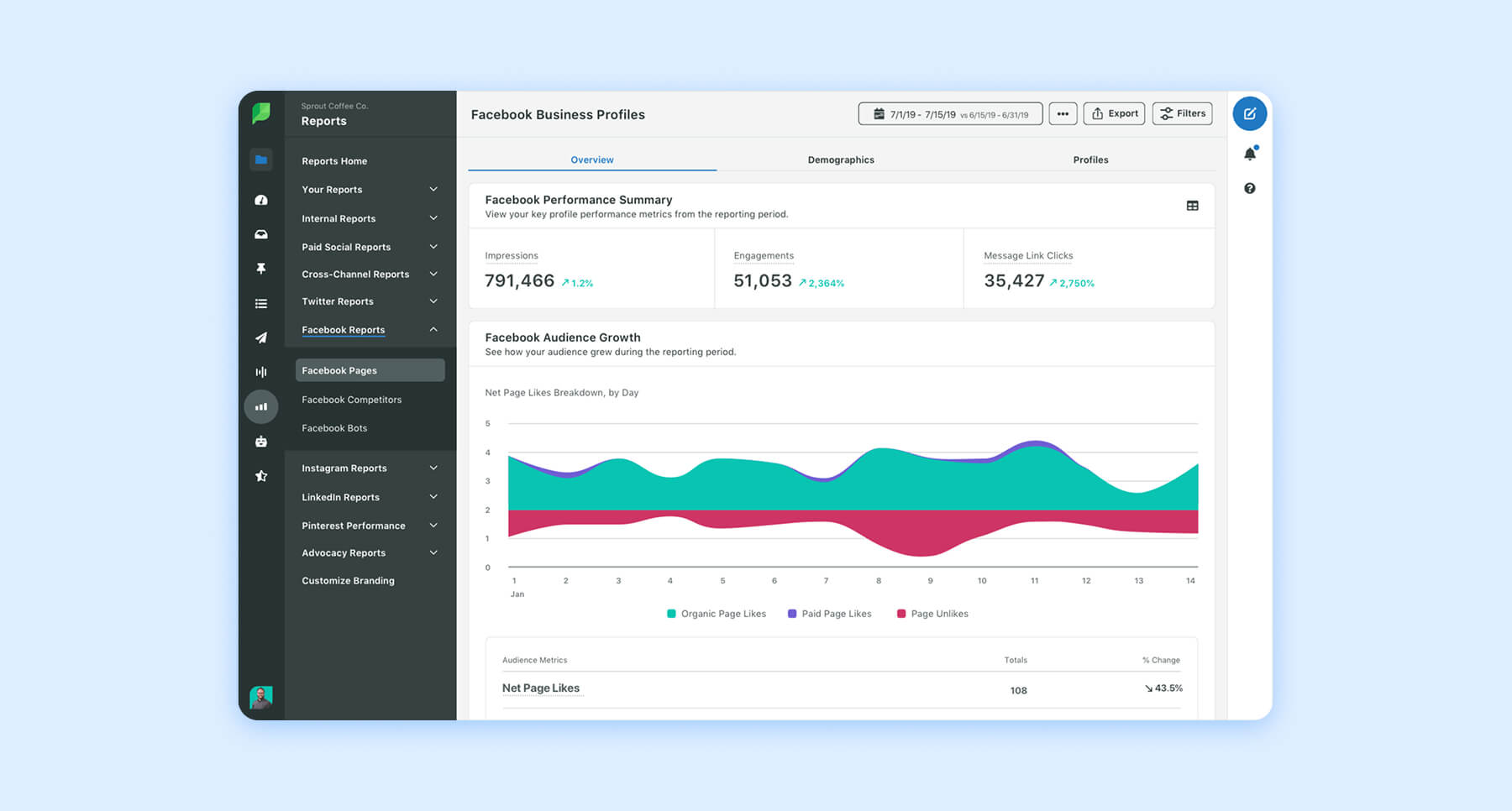Facebook Analytics Tips and Tools to Grow Your 2025 Strategy
With so many Facebook metrics available, what are the most important to measure? We break it down.

If you don’t measure your goals, wins, and failures, how do you know when you’re successful? Simply put, you won’t. Facebook analytics are the key to identifying success, unlocking opportunities, and figuring out what doesn’t work.
Without defining which metrics are most valuable to your Facebook marketing strategy and connecting to your business goals, you’re essentially posting into the void. And yes, your content might resonate with your audience, which could result in conversions, but without meaningful measurement, you simply can’t prove long-term success.
TL;DR:
- Connect analytics to defined business and social media objectives, focusing only on KPIs that drive results.
- Use insights to increase engagement, refine targeting, and improve campaign ROI.
- Demographic and behavioral data help create relevant content, reach new segments, and build loyalty.
- Tracking top-performing posts and comparing against competitors shows where to pivot and improve.
- Monitoring the same metrics over time creates reliable Facebook benchmarks, reveals trends, and supports data-driven decisions.
What Is Facebook Analytics?
Facebook analytics are metrics that relate to different aspects of your Facebook performance, such as impressions, likes, clicks, reach, and more. These analytics can also inform you about who your audience is and which demographics they belong to, like age, gender, and general geographical information.
For social media marketers, you should define which Facebook metrics are most relevant for your social media KPIs and how these KPIs directly impact your social media goals. On Facebook, in particular, there are many metrics available, but tracking all of them is not an impactful use of your team’s time. Define your goals, connect them to metrics, and set appropriate KPIs to ensure you approach Facebook analytics strategically.
What Is Facebook Insights?
Facebook Insights is Meta’s analytics tool for Facebook, available within Meta Business Suite as well as on the native platform. Some marketers may also refer to ideas, tactics, or broad conclusions made from Facebook metrics as ‘Facebook insights’.
An easy way to remember this is to think of metrics or analytics as numbers, and insights as the action or learning you take away from the numbers.
The Benefits of Facebook Analytics
Without Facebook analytics, you’re posting without insight into how your content performs or contributes to your broader marketing goals.
Facebook analytics are important to help your team ideate valuable insights about where to pivot and which strategic changes to make to your social media strategy. Other benefits of using Facebook analytics include:
Increase Engagement
Measuring your Facebook analytics helps you increase engagement by pinpointing opportunities in your content. For example, if you’re using a product catalog on Facebook to showcase products but notice your audience isn’t liking or commenting on your product posts, it might time to adjust your approach. This lack of interaction can indicate a need to switch up your visuals and copy, or maybe even introduce shoppable elements like Product Tagging (if you’re not using them already).
Track Long-Term Performance
If you can remember social media performance from weeks, months, and even years past in your head, you’re leagues ahead of many social marketers. For us mere mortals, however, analytics are necessary to track long-term performance and compare growth and declining metrics over time. Measuring past performance is essential for strategically identifying ways to adjust your Facebook strategy.
Monitor Competitors
Any shrewd social media marketing strategy includes competitive analysis. Without benchmarking your performance compared to competitors or seeing where your competition shines, you’ll never have a complete picture of what’s happening in your niche. Monitoring competitor performance lets you see where you’re winning, where you have room to pivot, and more.
Understand Your Audience
Most social media teams have a target demographic in mind, often more than one, depending on the scope of their business. Audience metrics let you discover more about who you’re reaching, which market segments they fall into (demographic, geographic, psychographic, and behavioral) and which content they respond best to. Conversely, these metrics help you determine who you’re not reaching. For example, are you targeting millennials aged 30-35, but are mostly reaching Gen Z? This could indicate a need to shift your brand’s expectations or tweak your strategy to include new tactics to help you reach your target audience.
Help Understand and Build Your Community
Performance metrics are important, but demographic insights reveal who you’re really speaking to. By understanding your community’s preferences, interests, and behaviors, you can create content that feels relevant and fosters long-term brand loyalty. These insights also help you identify untapped audience segments and guide your team in creating a Facebook community that feels more personal, connected, and aligned with your brand’s goals.
Help Identify Top-Performing Content
When you know what content works, you can build off your momentum and make more of the content that helps you achieve your goals. This is an easy way to identify where you should focus your content creation efforts. Does your audience like, comment, and engage with video content, but don’t favor visuals like infographics? This helps you pivot from what doesn’t work, and hone in on the content that does.
Help Maintain Consistent, Reliable Reporting
Measuring the same analytics over time helps you build reports for your team and other relevant stakeholders. Consistent reporting can develop long-term insights and give you a valuable perspective on historical performance. It also makes it easier to spot trends, track progress toward goals, and adjust strategy with confidence. Over time, these insights become a reliable benchmark for evaluating growth and success.
How To Access Facebook Insights and Analytics: Step-by-Step Walkthrough
Here’s how to access Facebook Insights on your desktop or mobile device.
- Log in to Facebook.
- Click your profile photo in the top right corner.
- From there, select ‘See all profiles’ and click the page you’d like to see Insights for.
- Click ‘Professional Dashboard’ in the left menu.
- Select ‘Insights’.
- Within Insights, choose the type of analytics you want to review, such as Overview, Content, Audience, or Revenue.
- You can also export your data from Insights if you want to build custom reports or analyze performance in more detail by clicking ‘Export Data’ in the top-right corner.
17 Facebook Insights To Track
Facebook has a wide variety of metrics to track. We’ve said it once, and we’ll say it again: the metrics your brand chooses to track will depend on your unique business and social media goals. Not trying to reach a new target demographic? Age and gender might not be your immediate focus. Wanting to understand the impact of your video strategy? Video retention and engagement should be a priority.
Facebook Audience Insights
Audience insights help you understand who you reach, which can also inform your strategy for reaching new audiences. Here are the different Facebook audience insights that are available to you:
1. Age
Age is the general age range of those interacting with your posts and page.
Why it matters → Helps brands tailor messaging, tone, and creative assets to resonate with focus demographics.
2. Gender
Shows which gender identities interact most with your posts and page.
Why it matters → Gender distribution helps you understand who you reach so that you can refine targeting and messaging.
3. Location
Location shows where your audience generally lives. This is often broken down by city, state, or country.
Why it matters → Helps you understand where your core audience is from, particularly useful if you have a global marketing strategy.
4. Language
What language does your audience speak? For example, you might be targeting Canada, but missing a portion of the audience who expects content in French.
Why it matters → Ensures messaging is accessible and culturally relevant, while helping your team spot missed opportunities to engage with different audiences.
5. Potential Audience
Potential audience is an ad metric that estimates how many people on Facebook match your target criteria, like demographics, interests, and behaviors.
Why it matters → Guides marketing budget allocation and campaign reach expectations, helping you scale boosted posts and paid social strategy campaigns.
Facebook Page Insights
Facebook Page Insights gives you a clear view of how people interact with your page and its content. From reach and visits to follower growth, these metrics show what’s working and where to adjust. It’s an essential tool for measuring progress and refining your strategy.
6. Reach
Reach measures how many unique users saw your page.
Why it matters → Helps measure content visibility and helps your team gauge which distribution strategies work best.
7. Visits
Tracks how many users viewed your page.
Why it matters → Page visits show how your content or ads are turning awareness into intent. Meaning people cared enough to click through, letting you gauge campaign effectiveness and movement down-funnel.
8. New Page Likes
New Page Likes show how many net new users ‘like’ your page.
Why it matters → Helps measure how many new followers you’re receiving, useful if you’re a new brand or a brand with growth and awareness as a social media KPI.
9. New Page Followers
New Page Followers represent the number of new users who have chosen to follow your brand, signaling growing audience interest and reach.
Why it matters → New followers expand your brand’s organic reach and signal that your content or campaigns are successfully converting casual viewers into an engaged audience.
10. Follower Growth Rate
Follower Growth Rate determines how your follower base is expanding over time.
Why it matters → Highlights momentum and the impact of campaigns on long-term audience building.
11. Page Virality Rate
Represents how often your content is shared relative to impressions.
Why it matters → Strong virality signals content that’s worth amplifying, and helps identify which content formats drive the highest organic reach.
Facebook Post Insights
Facebook Post Insights break down individual post performance, showing how many people saw, engaged with, and acted on your content. These metrics help you pinpoint which posts resonate most so you can refine your content strategy and boost future results.
12. Post Reach
Post Reach measures the amount of reach an individual post holds.
Why it matters → Helps determine which posts are boosted by the Facebook algorithm and bring the most visibility.
13. Post Engagement
Measures likes, comments, shares, and reactions on individual posts.
Why it matters → Engagement reflects how well content resonates and fosters community interaction.
14. Link Clicks
Link Clicks count how many times a link is clicked overall.
Why it matters → Demonstrates how effective content is at driving visits, revenue, and engagement.
Facebook Video Insights
Facebook video insights provide detailed metrics on how viewers interact with your videos, from watch-time, to engagement. These insights help you understand what captures attention, where viewers drop off, and which videos drive the strongest connection with your audience.
15. Video Retention
Video Retention measures how long viewers watch a video and where they drop off.
Why it matters → Identifies the ideal video length for your audience, and can gauge which content they resonate most with.
16. Average View Duration
Average View Duration shows how long viewers stay engaged with your videos, revealing how effectively your content captures attention.
Why it matters → Higher watch times signal stronger engagement, better algorithm performance, and greater potential to drive actions.
17. Video Engagement
Video Engagement uses video views, watch time, engagement actions (likes, comments, shares, saves), and audience retention to determine how engaging a piece of video content is.
Why it matters → Along with retention, video engagement is key to understanding how your video content resonates with audiences.
4 Facebook Analytics Tips To Achieve Your Goals
You already know what Facebook analytics are and why they’re important. Now, it’s time to put this knowledge into action and explore how insights can drive smarter decisions.
1. Only Track Metrics Relevant To Your Goals
Say it with me: not all metrics are important. Yes, this is a bold statement, but tracking every available metric at your fingertips is an easy way to waste time creating reports when that time could be used to strategize, create content, and conduct valuable research (like diving into social media benchmarks). Analytics still matter, but the most valuable metrics are the ones tied directly to your business goals.
Is the top priority sales conversions? Website clicks and traffic to product pages should be your focus. Draw a line from your goal to the relevant metric, set a realistic but ambitious KPI, and measure continuously to see what works.
2. Use Audience Insights To Refine Your Targeting Strategy
Facebook ads and boosted posts let you precisely define your target audience, reducing wasted spend and aligning who you target with who engages, and ultimately who converts or submits a lead form.
Your targeting strategy doesn’t just extend to ads; it also helps inform your organic content strategy. Are you trying to reach millennials, but they don’t engage with your product posts or educational content? Here’s your chance to conduct more research, see what they’re likely to engage with, and create more of that type of content. Maybe it’s working with a particular creator or just changing your design, but audience insights are valuable when refining your content or demographic targeting strategy.
3. Monitor Engagement Trends To Optimize Posting Times
Yes, you can just look at the best time to post on Facebook, but monitoring engagement and finding patterns between high engagement and when that content is posted can help you refine your brand’s best time to post. What’s more, with a variety of content types on Facebook, you might uncover unique trends like product posts performing better on the weekend, or posts in Facebook Groups gaining more engagement during the evening.
4. Leverage Facebook Analytics Tools for Deeper Reporting
Facebook’s native analytics are quite robust compared to other platforms. However, third-party analytic tools are a must for any savvy brand that wants to explore its performance fully. Social media analytics tools often offer capabilities you can’t get on a native platform, like cross-channel reporting, deeper customer insights, and providing one source of truth for your entire social media performance.
Top 3 Facebook Analytics Tools
The best Facebook analytics tools depend on your priorities, from the metrics you track to the content you schedule and your team’s workflow. Below are three widely used Facebook analytics tools to help you pick the best match for your team.
1. Dash Social
Dash Social’s Facebook Insights give brands everything they need to measure, compare, and optimize performance in one place. Teams can track key metrics like reach, engagement, and follower growth across multiple pages while easily benchmarking against competitors to spot competitive opportunities and gaps. Dash Social’s Facebook analytics reports connect content performance to broader business goals, making it easy to share insights with stakeholders and cross-functional teams. With customizable dashboards, Dash Social offers brands the full context they need to understand trends, refine strategy, and prove the impact of their Facebook strategy.

2. Sprout Social
Sprout Social’s Facebook analytics provide reports based on organic and paid aspects of a brand’s Facebook Pages, Facebook Competitors, and Facebook Chat Bots. Page-level reports let your team track reach, engagement, and follower growth, while competitive reports help benchmark your success against other brands to help you find opportunities in your Facebook strategy. A unique offering from Sprout is its Facebook Chat Bot Analytics, which provides visibility into automated conversations to help teams learn from customer interactions and improve responses. Together, these analytic reports offer a broad picture of how your Facebook tactics work together.

3. Hootsuite
Hootsuite’s Facebook analytics let marketers monitor performance, track audience engagement, and measure ROI across their pages. Users can see metrics like reach, impressions, engagement rate, and follower growth in customizable dashboards that make reporting simple. Hootsuite also allows teams to compare performance over time and across different campaigns, helping identify top-performing content and audience trends. With built-in reporting and export features, it’s easy to share insights with stakeholders and keep strategies aligned to business goals.

Facebook Analytics FAQs
How do I access Facebook insights?
To access Facebook Insights, log in to your account and switch to the Page you want to manage. From the left-hand menu, click ‘Professional Dashboard’, then select Insights. This section provides detailed analytics on your content, audience, and overall Page performance.
Where is the insights tab on my Facebook page?
The Insights tab is located in the Professional Dashboard of your Page. Once on your Page, look at the left-hand navigation menu and click ‘Professional Dashboard’. From there, you’ll see ‘Insights’ listed as an option.
Why can’t I see insights on Facebook?
You can’t see Facebook Insights if you don’t have a Facebook Business account. If you’re unable to see Facebook Insights with a Facebook Business account, your audience might be too small. If you have a robust, engaged audience and still can’t see Facebook Insights, try refreshing your page or reaching out to customer support.
How can I increase Facebook page reach?
If you’re focused on brand awareness and reaching new people, you can increase your Facebook page’s reach by responding to comments, engaging with other relevant Facebook content, working with influencers, and collaborating with other brands.



.jpg)

.webp)